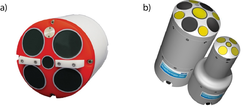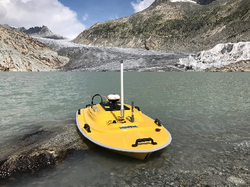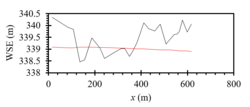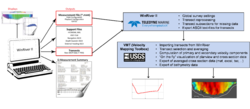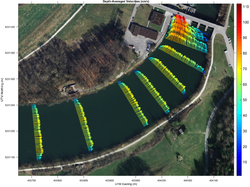Structure from motion (SfM)
Contents
Quick summary
Developed by: Various Companies
Date:
Suitable for the following measures:
Introduction
The technique of structure from motion was developed for the gaming industry to allow fast and easy 3D detection and evaluation of bodies. With this technique, it is possible, based on pictures of an object taken with a camera to combine these pictures and based on a software evaluation There are several approaches to generate a 3D model from SfM. In incremental SFM (Schönberger & Frahm 2016), camera poses are solved and added one by one. In global SFM (Govindu 2001), the poses of all cameras are solved for at the same time.
The best result can be achieved when taking pictures from every angle around the object. However, this is not possible for rivers, depending on the river bank vegetation only a flight directly above but with no relevant angle to the sides is possible (Figure 69).
The same problem might appear when using the technique in the lab (Figure 70).
For a sufficient accuracy of the results, at least a camera with a high quality GPS sensor needs to be used. The use of targets or even coded targets would be more favourable, however. Without a clear positioning of the pictures in the space, the result would not be correct as the cameras could not be located correctly in dependency to each other. Targets on the ground, especially for field measurements, are highly recommended. The position of the targets can be measured with a GPS and the targets can be redetected later in the pictures.
Depending on the software used this process of “re-finding” can be done automatically or needs to be done manually.
Again, there are different types of software available, commercial and non-commercial ones. As there is a very fast development and most non-commercial tools need a lot of experience with picture modifications etc. it is recommended, despite the costs, to use a commercial one such as Agisoft Photoscan for instance. In this software, the user can follow relatively easy the workflow provided by the program (Figure 71) to produce a DEM.
Application
As for other picture-based evaluation methods, the data processing is the most demanding part of the measurement. When starting with the measurements in the field, it is highly recommended to use targets. The rough workflow is as follows:
- Putting targets on the ground with sufficient visibility. The quality of the results increases in case there are two to three targets visible in every picture. Hence the distribution of the targets depend on the flight height of the camera.
- The camera is usually mounted on a drone, however other constructions as a crane etc. are possible.
- Speed and height over ground depend on the area to be evaluated.
- In case large areas need to be covered an automated flight route programmed for the drone would be useful.
- Starting and landing the drone can be a crucial point, especially in the case this is done automatically and the connection is nut sufficient.
- Further problems can be caused by wind (for the flying performance) and by reflections (for the resulting pictures).
Once the measurements are done the evaluation is the most crucial point. Depending on the number of pictures evaluated the result quality de- or increases and in a reverse way the computer performance and power needed in- or decreases (Figure 72).
Other information
The highest cost is the software license in case a commercial product is used.
Relevant literature
- Mueller, D.S., Wagner, C.R., Rehmel, M.S., Oberg, K.A., Rainville, F. (2013). Measuring discharge with acoustic Doppler current profilers from a moving boat (ver. 2.0, December 2013), U.S. Geological Survey Techniques and Methods, book 3, chap. http://dx.doi.org/10.3133/tm3A22.
- Simpson, M.R. (2002). Discharge measurements using a broadband acoustic Doppler current profiler. Open-file Report 2001-1, https://doi.org/10.3133/ofr011.
Links to the suppliers of equipment:
- Teledyne Marine, ADCP RiverPro: http://www.teledynemarine.com/riverpro-adcp?ProductLineID=13
- Teledyne Marine, Q-Boat: http://www.teledynemarine.com/Lists/Downloads/Q-Boat_1800_Datasheet.pdf
- Hemisphere Atlas DPS: https://hemispheregnss.com/Atlas/atlaslinke284a2-gnss-smart-antenna-1226
- Sontek ADCP M9: https://www.sontek.com/riversurveyor-s5-m9
Software for ADCP data analysis:
- Velocity Mapping Toolbox: https://hydroacoustics.usgs.gov/movingboat/VMT/VMT.shtml
- Q-GIS: https://qgis.org/en/site/
